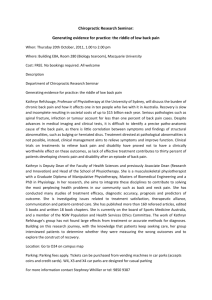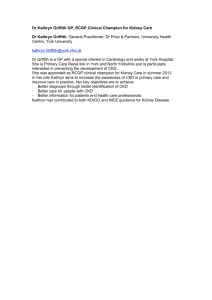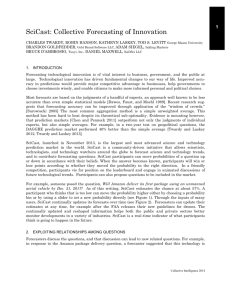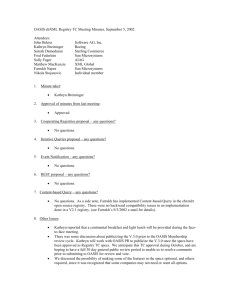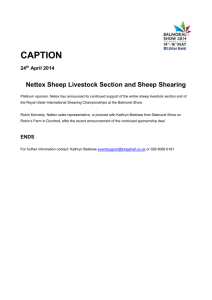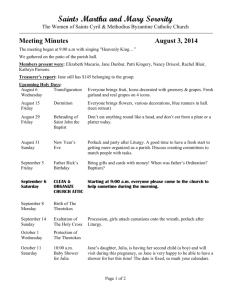Unit 3: DSS Elements: The Model Subsystem (1)
advertisement
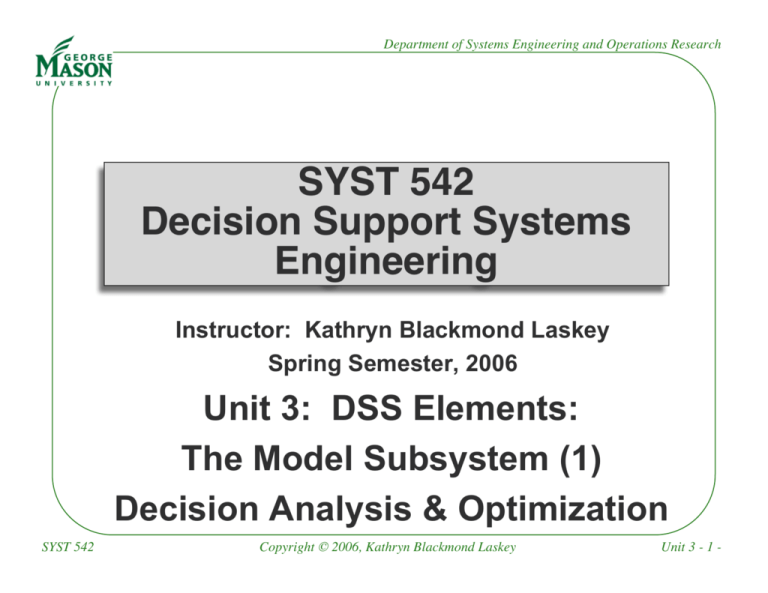
Department of Systems Engineering and Operations Research
SYST 542
Decision Support Systems
Engineering
Instructor: Kathryn Blackmond Laskey
Spring Semester, 2006
Unit 3: DSS Elements:
The Model Subsystem (1)
Decision Analysis & Optimization
SYST 542
Copyright © 2006, Kathryn Blackmond Laskey
Unit 3 - 1 -
Department of Systems Engineering and Operations Research
Outline
• Developing the model subsystem
• Role of decision theory in DSS
• Brief survey of decision analysis
and optimization methods
SYST 542
Copyright © 2006, Kathryn Blackmond Laskey
Unit 3 - 2 -
Department of Systems Engineering and Operations Research
Models and DSS
• A model is a representation of a system which
can be used to answer questions about the
system
• A DSS uses computer models in conjunction
with human judgment
– Performs computations that assist user with decision problem
– Design is based on a model of how human user does / ought to solve
decision problem
• Model subsystem can be:
– completely automated
– partially automated
– manual with automated support for information entry,
retrieval and display
SYST 542
Copyright © 2006, Kathryn Blackmond Laskey
Unit 3 - 3 -
Department of Systems Engineering and Operations Research
DSS and Exploratory Models
• DSS modeling is by definition exploratory
– Human remains in the loop
• Consolidative model may be possible for parts
of problem
– Avoid the temptation to pour too many resources into the
part you know how to model!
• Good DSS helps DM make use of partial
information
– to generate hypotheses about system behavior
– to demonstrate occurrence of types of behavior under nottoo-implausible assumptions
– to explore possible risks / failure modes
– to determine regions of parameter space in which certain
qualitative behaviors occur
SYST 542
Copyright © 2006, Kathryn Blackmond Laskey
Unit 3 - 4 -
Department of Systems Engineering and Operations Research
Issues for Exploratory Modeling
• Representing the ensemble of models
– internal system representation
– decision maker’s mental model
– language for communicating with decision maker
• Tools for allowing DM to explore alternative
modeling assumptions
–
–
–
–
what-if analysis
sensitivity analysis
exploring different parts of parameter space
exploring different combinations of modeling assumptions
• Techniques for helping DM assess consequences of
alternative assumptions
– summaries of high-dimensional data
– graphical displays
SYST 542
Copyright © 2006, Kathryn Blackmond Laskey
Unit 3 - 5 -
Department of Systems Engineering and Operations Research
Steps in Developing
the Model Subsystem
1. Map functions in decision process onto
models
2. Determine input / output requirements for
models
3. Develop interface specifications for models
with each other and with dialog and data
subsystems
this step may result in additional modeling activity
4. Obtain / develop software realizations of the
models and interfaces
SYST 542
Copyright © 2006, Kathryn Blackmond Laskey
Unit 3 - 6 -
Department of Systems Engineering and Operations Research
Decision Process (review)
Identify Problem
Identify Objectives
(values)
Use of
DSS
{
Identify Alternatives
Decompose and Model Problem
– Structure
– Uncertainty
– Preference
Choose Best Alternative
Sensitivity Analysis
More
Yes
Analysis
Needed
No
Make Recommendation
SYST 542
Copyright © 2006, Kathryn Blackmond Laskey
Thanks to Andy Loerch
Unit 3 - 7 -
Department of Systems Engineering and Operations Research
Some Typical Problems to Model
• Evaluate benefits of proposed policy against costs
• Forecast value of variable at some time in the
future
• Evaluate whether likely return justifies investment
• Decide where to locate a facility
• Decide how many people to hire & where to assign
them
• Plan activities and resources for a project
• Develop repair, replacement & maintenance policy
• Develop inventory control policy
SYST 542
Copyright © 2006, Kathryn Blackmond Laskey
Unit 3 - 8 -
Department of Systems Engineering and Operations Research
A Brief Tour of Modeling Options
• A wide variety of modeling approaches is
available
• DSS developer must be familiar with broad
array of methods
• It is important to know the class of problems
for which each method is appropriate
• It is important to know the limitations of each
method
• It is important to know the limitations of your
knowledge and when to call in an expert
SYST 542
Copyright © 2006, Kathryn Blackmond Laskey
Unit 3 - 9 -
Department of Systems Engineering and Operations Research
Decision Theory
• Formal theory to support GOOD-D process
• Goals (What do I want?)
– Begin with value-focused thinking
– Quantify values with utility function
• Options (What can I do?)
• Outcomes (What might happen?)
– Quantify uncertainty with probability distribution
• Decide:
– Develop a mathematical model of expected utility for each option
– Model recommends the option for which expected utility is greatest
– In a good decision analysis, model building process increases
understanding of decision problem
– The model gives insight but the decision maker makes the final choice
• Do it!
– Discussion and evaluation of options should consider issues of
implementation
SYST 542
Copyright © 2006, Kathryn Blackmond Laskey
Unit 3 - 10 -
Department of Systems Engineering and Operations Research
Role of Decision Theory in DSS
• Avoid “elicit model out of decision maker’s
head, push the button and solve for the correct
answer” mentality
• Decision theoretic models are appropriate
when:
– We can quantify values and uncertainties to a reasonable
approximation
– It is useful to suggest potentially optimal solutions and/or
to weed out clearly suboptimal solutions
• Useful outputs (in addition to recommended
solution)
– Explanation of results
– Sensitivity analysis
– Visualization of feasible region
SYST 542
Copyright © 2006, Kathryn Blackmond Laskey
Unit 3 - 11 -
Department of Systems Engineering and Operations Research
Decision Analysis
• Collection of analytic and heuristic procedures for
developing decision theoretic model
• Goals of decision analysis
– Organize or structure complex problems for analysis
– Deal with tradeoffs between multiple objectives
– Identify and quantify sources of uncertainty
– Incorporate subjective judgments
• Decision analysis methods help to:
– decompose problem into subproblems which are easier to solve
– detect and resolve inconsistencies in solutions to the
subproblems
– aggregate solutions to subproblems into a consistent action
recommendation for the original problem
SYST 542
Copyright © 2006, Kathryn Blackmond Laskey
Unit 3 - 12 -
Department of Systems Engineering and Operations Research
Decision Analysis Methods
• Value Models: Multiattribute Utility
• Uncertainty Models: Decision Trees
– A structured representation for options and outcomes
– A computational architecture for solving for expected utility
– Best with “asymmetric” problems (different actions lead to qualitatively
different worlds)
• Uncertainty Models: Influence Diagrams
– A structured representation for options, outcomes and values
– A computational architecture for solving for expected utility
– Best with “symmetric” problems (different actions lead to worlds with
qualitatively similar structure)
• Decision analysis software:
– http://faculty.fuqua.duke.edu/daweb/dasw.htm (there are some broken
links)
SYST 542
Copyright © 2006, Kathryn Blackmond Laskey
Unit 3 - 13 -
Department of Systems Engineering and Operations Research
Example: Patient Treatment
A patient is suspected of having a disease. Treated patients
recover quickly from the illness, but the treatment has
unpleasant side effects. Untreated patients suffer a long
and difficult illness but eventually recover.
Goals:
•
Recovery
•
Freedom from side effects
Options:
•
Utility
Speed of
Recovery
Treat of don’t treat
Outcomes:
•
Sick/Well
•
Side Effects / No Side Effects
Side
Effects
Multiattribute
Hierarchy
UT
Treat
Disease
Don’t
treat
Disease
Outcome
Treatment
SYST 542
Utility
No disease
UD
UN
Decision Tree
Influence Diagram
Copyright © 2006, Kathryn Blackmond Laskey
Unit 3 - 14 -
Department of Systems Engineering and Operations Research
Value Model
• Objectives related to alternatives by Attributes
• Attributes are measures of achievement of objectives
– Quantitative
– Reflect consequences
• Usually decision maker has multiple objectives
– Objectives are often in conflict
– Value model incorporates tradeoffs among objectives
• Types of value model
– Ordinal - ranking only
– Measurable value function - strength of preference
– Utility function - includes risk attitude
• Medical example:
– Need to assess relative degree of misery of side effects vs illness
– Need utility model to trade off chance of illness against cost of
side effects
SYST 542
Copyright © 2006, Kathryn Blackmond Laskey
Unit 3 - 15 -
Department of Systems Engineering and Operations Research
Constructing a Value Model
• Decompose objectives
– Independent components of value (avoid double-counting)
– Begin with fundamental objective and decompose into important means
objectives
• Find ways to measure objectives
– Natural attribute (e.g., cost in dollars, weight in pounds)
– Constructed attribute (e.g., consumer price index for inflation)
– Proxy attribute (e.g., sulfur dioxide emissions for erosion of monuments
from acid rain)
• Combine objectives
– Turn attribute scores into value function
» Better options have higher value
» Equal differences in value function are equally valued by DM
– Functional form depends on relationship between attributes
» Most common combination method is linear additive with cutoffs
» Justification depends on independence assumptions
– Weights trade off objectives against each other
» Subjective
» Need to consider range of weights
• Adjust for risk attitude if necessary
SYST 542
Copyright © 2006, Kathryn Blackmond Laskey
Unit 3 - 16 -
Department of Systems Engineering and Operations Research
Linear Additive Value Function
• Value function is weighted sum of singleattribute value functions
– v(x1, …, xn) = w1v1(x1) + … + wnvn(xn)
• Requires attributes to be preferentially
independent:
– Preference order between levels of any pair Xi and Xj of
attributes does not depend on levels of other attributes
• Much simpler to specify and use than more
complex functional forms
• Try to specify attributes to be preferentially
independent
SYST 542
Copyright © 2006, Kathryn Blackmond Laskey
Unit 3 - 17 -
Department of Systems Engineering and Operations Research
Example
Multiattribute Hierarchy:
Buying a Beach House
•
– nonoverlapping
– cover all important aspects of value
– bottom level attributes are measurable
Initial
Investment
Financial
•
NPV
Total
Utility
•
Assess function for combining
attributes at each level (usually linear
weighted average)
Compute utilities of all options
– score on bottom-level attributes
– compute overall score
Time Spent
Enjoyment
Decompose value into attributes
Luxury
Walking time
Ocean access
View
SYST 542
Copyright © 2006, Kathryn Blackmond Laskey
Unit 3 - 18 -
Department of Systems Engineering and Operations Research
Assessing Weights:
Swing Weight Method
•
First weight
– Imagine all attributes are at worst level (may be imaginary)
– Which would you choose to increase to best level?
– Assign this attribute weight of 1
•
Rest of weights
– All attributes are at worst level again
– Pick another attribute to move to best level
– What % of value of moving first to its best level?
•
Scale all weights to sum to 1
Beware: Some commonly
used weight assessment
methods ignore absolute
scale of attributes and can
lead to preference reversals.
Best
70%
w2 = 0.7 w1
w1 + w2 = 1
Best
w1 = 0.59
w2 = 0.41
Worst
Attribute 1
SYST 542
Worst
Attribute 2
Copyright © 2006, Kathryn Blackmond Laskey
Unit 3 - 19 -
Department of Systems Engineering and Operations Research
Analytic Hierarchy Process
• Popular method for building a preference
model
• Problem decomposition into multiattribute
hierarchy is same as for multiattribute utility
• Method of assigning weights is different
– Based on paired comparisons
– Pairs of options are compared on scale from 0 to 9
– Ratings are used to develop weights for the value function
• Comments
– Method is popular because paired comparisons are natural
and intuitive to many decision makers
– Theoretical justification of the MAU “swing weight”
assessment is lacking
– Can have preference reversals when options are added or
removed from the option set (i.e., whether we prefer A to B
may depend on whether or not C is under consideration)
SYST 542
Copyright © 2006, Kathryn Blackmond Laskey
Unit 3 - 20 -
Department of Systems Engineering and Operations Research
Decision Analysis Example:
Texaco vs Pennzoil (1984)
•
•
•
•
Pennzoil and Getty agreed to merge
Texaco made Getty a better offer - Getty reneges
Pennzoil sues, wins case in 1985, get $11.1 Billion
Texas appeals court reduces judgment by $2 Billion
– With court costs and interest $10.3 Billion
– Texaco threatened to bankrupt and go to Supreme Court
• 1987, before Pennzoil starts issuing liens Texaco offers to settle
for $2 Billion
• Pennzoil thinks $3-5 Billion is a fair price
• What should Hugh Liedtke, CEO of Pennzoil, do?
SYST 542
Copyright © 2006, Kathryn Blackmond Laskey
Unit 3 - 21 -
Department of Systems Engineering and Operations Research
Decision Tree for Pennzoil’s Problem
(simplified model)
Result ($B)
Accept $2 Billion
2
Texaco Accepts $5 Billion
0.2
0.17
Counteroffer
$5 Billion
0.50
0.33
How could this model be made more complex?
SYST 542
Final Court
Decision
0.5
0.3
Texaco
Refuses
Counteroffer
Texaco
Counteroffers
$3 Billion
5
0.2
Final Court
Decision
0.5
0.3
Accept $3 Billion
Copyright © 2006, Kathryn Blackmond Laskey
10.3
5
0
10.3
5
0
3
Unit 3 - 22 -
Department of Systems Engineering and Operations Research
Influence Diagram
•
Activity
Test
Carcinogenic
Activity
Exposure
Test
–
–
–
–
Human
Exposure
•
Cancer
Cost
Usage
Decision
Alternative representation of
decision problem
Net
Value
Ovals are “chance nodes”
Boxes are “decision nodes”
Rounded boxes are “value nodes”
Arcs show influences
Formally equivalent to decision
tree
– Probability and utility values are
encapsulated inside the nodes
– Some software packages switch back
and forth between views
Economic
Value
• Dotted lines are information arcs
• Whether to collect information can be represented as a decision problem
• Note: influence diagram represents multiattribute utility function explicitly
SYST 542
Copyright © 2006, Kathryn Blackmond Laskey
Unit 3 - 23 -
Department of Systems Engineering and Operations Research
Some Simple
Qualitative Rules
• Dominance
– If Option X is at least as good as Option Y on all attributes
of value, Option X is at least as good as Option Y
– If Option X is at least as good as Option Y for each
possible outcome, then Option X is at least as good as
Option Y
• Useless Information: If information gathering
is costly and the result would not change your
decision, then do not gather the information
SYST 542
Copyright © 2006, Kathryn Blackmond Laskey
Unit 3 - 24 -
Department of Systems Engineering and Operations Research
Mathematical Programming
• Constrained optimization problems:
– Maximize or minimize objective function
– Subject to constraints defining feasible region of solution space
• Solution methods:
– Linear programming (LP)
» Objective function and constraints are linear
– Nonlinear programming (NLP)
» Objective function and/or some constraints are nonlinear
– Integer programming (IP)
» Feasible space consists of integer variables
– Mixed integer programming (MIP)
» Feasible space consists of some integer and some real variables
– Goal programming (GP)
» Try to find at least one solution in feasible region
– Dynamic programming (DP)
» Find optimal policy in sequential decision making problem
• Traditional mathematical programming ignores uncertainty
SYST 542
Copyright © 2006, Kathryn Blackmond Laskey
Unit 3 - 25 -
Department of Systems Engineering and Operations Research
LP Example
• A company makes 3 types of furniture:
Type
Profit
/item
Chair
Bench
Table
$50
$100
$75
Labor
Required
(hours)
10.5
15
17
Materials
Required
(sq ft)
5
15
10
Minimum
Qty
5
7
5
° Objective: Find the highest profit combination of items to manufacture
° Constraints:
- Labor hours available = 400
- Lumber available = 300
- Must make at least minimum quantity of each item
Thanks to Andy Loerch
SYST 542
Copyright © 2006, Kathryn Blackmond Laskey
Unit 3 - 26 -
Department of Systems Engineering and Operations Research
LP Formulation
Maximize
50 c + 100 b + 75 t
s.t. 10.5 c + 100 b + 17 t
5 c + 15 b + 10 t
c
b
t
profit
≤
≤
≥
≥
≥
400
300
5
7
5
labor
lumber
chairs
benches
tables
Thanks to Andy Loerch
SYST 542
Copyright © 2006, Kathryn Blackmond Laskey
Unit 3 - 27 -
Department of Systems Engineering and Operations Research
Solving Linear Programs
• Simplex method - developed by Dantzig in 1940’s
–
–
–
–
Standard method
Exponential in number of variables
Guaranteed to give optimal solution
Searches extreme points in feasible region
• Karmarkar’s algorithm - 1980’s
– Polynomial time
– Very fast on large problems
– Limited ability to do sensitivity analysis
• Specialty algorithms exploit special case
structures
– Transportation method
– Network simplex
SYST 542
Copyright © 2006, Kathryn Blackmond Laskey
Unit 3 - 28 -
Department of Systems Engineering and Operations Research
Goal Programming
• Define goals (aspiration levels) as constraints:
– f(x) ≥ b; f(x) ≤ b; f(x) = b
• In standard LP these would be constraints
defining feasible region
• In GP we try to minimize deviation from goal
–
–
–
–
SYST 542
Minimize weighted sum of goal deviations
Minimize some other function of goal deviations
Minimize worst deviation
Lexicographically minimize ordered set of goal deviations
Copyright © 2006, Kathryn Blackmond Laskey
Unit 3 - 29 -
Department of Systems Engineering and Operations Research
Solving Integer Programs
• Most IPs and MIPs are binary
– General integers expressed as sums of binaries with
rounding
• Standard method: Branch and bound
– Solve LP with integer constraints relaxed
– Choose a variable to branch on
» Make 2 problems - set chosen variable to 1 or 0
» Solve both relaxed problems
– Repeat till best integer solution is found
– Worst case: 2n LPs to solve
» Can explode rapidly
SYST 542
Copyright © 2006, Kathryn Blackmond Laskey
Unit 3 - 30 -
Department of Systems Engineering and Operations Research
Solving Nonlinear Programs
• Standard methods
– Steepest descent
– Conjugate gradient
• Convexity is important
– Using standard NLP solvers on non-convex problems can
give local (not global) optimum!!
– Stay tuned (next week) for more on non-convex problems!
g(x)
Non-convex Function
Local min
Global min
x*
SYST 542
x
Copyright © 2006, Kathryn Blackmond Laskey
Unit 3 - 31 -
Department of Systems Engineering and Operations Research
Solving Mathematical Programs
• Special purpose optimization packages
– e.g., OSL, CPLEX
– Linear, nonlinear, integer programs
• Spreadsheet add-ins
– e.g., Excel’s solver
– Easily available, don’t need to learn new package or
interface to external software
– Usually limited (e.g., LP only; size limits)
• Many problems cannot be solved exactly
– Heuristic methods are used
– Interface between AI and OR/MS
SYST 542
Copyright © 2006, Kathryn Blackmond Laskey
Unit 3 - 32 -
Department of Systems Engineering and Operations Research
Solving LP Using Excel Solver
(1) Logically organize data (label, etc.)
• Coefficients for objective function
• Coefficients for constraints
• RHS of the constraints
(2) Reserve cells for the decision variables
– Called Changing Cells
(3) Create formula in a cell for the objective function
– Called Target Cell
(4) Create a formula for the LHS of each constraint
(5) Open Solver Dialog box (Tools menu)
(6) Enter the appropriate info and run Solver
Thanks to Andy Loerch
SYST 542
Copyright © 2006, Kathryn Blackmond Laskey
Unit 3 - 33 -
Department of Systems Engineering and Operations Research
Sensitivity Analysis
• One-variable sensitivity analysis
– How sensitive is solution to change in parameter (weight in
objective function or constraint value)?
– Simplex method can produce one-variable sensitivity
analysis as a by-product
• Parametric analysis
– Specify range of values for parameter or parameters
(weight on objective function; value of constraint;
probability)
– Evaluate change in solution as parameters vary through
range
SYST 542
Copyright © 2006, Kathryn Blackmond Laskey
Unit 3 - 34 -
Department of Systems Engineering and Operations Research
Visualizing Sensitivity
Analysis Results
Sensitivities to Parameters
• Tornado Diagram
D
– Visualizes result of varying a
set of parameter through
specified ranges on an
output of interest
L
R
S
• Strategy Region Graph
– Visualizes changes in
optimal strategy as 2
parameters are varied
through a range
Parameter 1
P
Parameter 2
SYST 542
Copyright © 2006, Kathryn Blackmond Laskey
Unit 3 - 35 -
Department of Systems Engineering and Operations Research
In Summary...
SYST 542
Copyright © 2006, Kathryn Blackmond Laskey
Unit 3 - 36 -
Department of Systems Engineering and Operations Research
References
•
•
•
SYST 542
Anderson, D., Williams, T., and Sweeney, T., An Introduction to Management
Science: Quantitative Approaches to Decision Making, Southwestern, 1999.
Clemen, R. Making Hard Decisions: An Introduction to Decision Analysis,
Duxbury, 1997.
Winston, W. Operations Research Applications and Algorithms, Duxbury, 1997.
Copyright © 2006, Kathryn Blackmond Laskey
Unit 3 - 37 -
